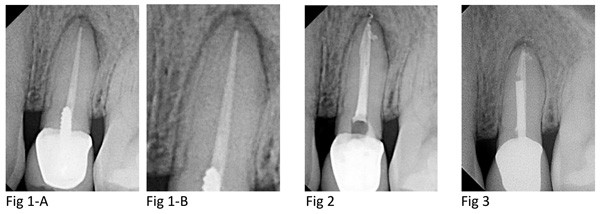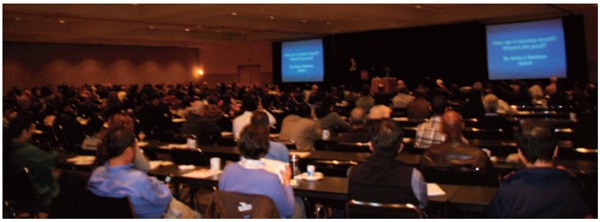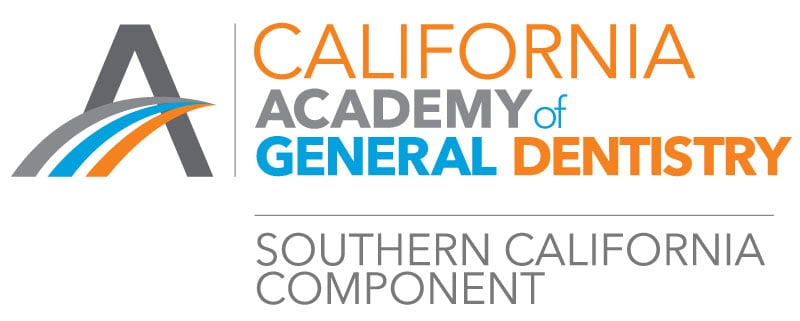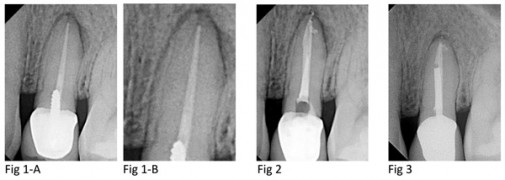- Managing Failing RCTs: Case selection of Retreatment vs. Apicoectomy vs.Extraction
- “ENDER’S GAME”: Success Lessons from Hollywood
- 2014 CAGD Annual Meeting January 25 and 26
- AGD News: AGD Auto-Renewal, Member Savings and Offers, Win a Trip to Hawaii
Managing Failing RCTs: Case Selection of Retreatment vs. Apicoectomy vs. Extraction.
Daryl Dudum, DDS
Private practice, Novato and San Rafael, CA
Dentists commonly encounter previously root canal treated teeth with recurrent infections during their examinations. The difficult question is to decide whether retreatment, apicoectomy, or extraction is the proper treatment modality.
The first step is to try to find the cause of the failure. During the examination, the tooth should be evaluated for coronal leakage, missed canals, inadequate filling material (long or short), fractures and associated bone loss, endodontic bone loss (vs. periodontal bone loss), perforations, and broken instruments.
At this point, a decision should be made whether the tooth can be saved with some form of endodontic therapy or if the tooth has a poor prognosis and is destined for extraction.
The following cases illustrate different scenarios of failing RCTs and their treatment approaches.
Case #1
A 35-year-old male had RCT and crown on #13 five years ago. He presented with pain to percussion and an ache in that area. Periodontal probing depths were WNL. The radiograph shows a lesion of endodontic origin (LEO) and a short metal post (Fig 1-A). The root canal filling looks about 1 mm short. The double ligament line on the mesial is indicative of a second canal that was missed (Fig 1-B); consequently, retreatment was the treatment of choice (Fig 2). A 1 year follow-up radiograph shows the continued healing of the LEO and the patient is asymptomatic (Fig 3).

Case #2
A 40-year-old female who is allergic to penicillin had RCTs on # 7 – 10 completed 2 months ago with a post and build-ups. The patient continued to experience pain to percussion on # 7 even after a dose of clindamycin. The radiograph shows a LEO on # 7 (Fig 4-A). Notice the distal curvature of the apical portion of the root while the root canal filling remains straight (Fig 4-B). That is an indication of either an apical perforation or complex apical anatomy. Consequently, apicoectomy was the treatment of choice (Fig 5-A,B). Figure 6 shows staining with methylene blue during root resection.

Case #3
A 45-year-old female presented with a previous RCT, a build-up, and a crown on #14 that were performed seven years ago. She presented with pain to percussion and the pre-op radiograph shows a broken instrument in MB2 and a LEO around the MB root (Fig 7-A,B). Ideally retreatment would be completed with removal of the broken instrument and negotiation of the entire canal. During, retreatment the file could not be removed without jeopardizing the prognosis, so an apicoectomy procedure was completed after retreatment of the other 3 canals. Figure 8 is retreatment post-op, Figure 9 is surgical post-op, and Figure 10 is a 1 year follow-up radiograph showing healing and the patient is asymptomatic.

Case #4
A 27-year-old female presented with previous RCT, a build-up, and a crown on # 19. She was sensitive to percussion and had a draining sinus tract on the buccal by the gingival margin. The LEO is a Jshaped lesion around the mesial root working into the furcation area (Fig 11-A,B). There was a narrow 12 mm buccal probing while all other probing depths were WNL. Because of the J shaped lesion and narrow probing depths, it was recommended that the tooth be extracted due to a vertical root fracture.
As evident from these cases, treatment planning in these situations is not easy. During the examination it is important to not only understand that the RCT is failing but WHY it is failing. Once that is understood, the correct treatment can be planned.
Dr. Dudum is an Endodontist in private practice at Marin Endodontics in Novato and San Rafael, CA. He can be reached at 415-898-7093, ddudum@gmail.com and www.Marinendodontics.com. The author reports no disclosures.
Editor’s Message: The GP NewsFlash is now accepting clinical briefs for publication. Click here to check the guidelines to clinical briefs and submit your clinical brief or any question you may have to: GPNF@cagd.com
“ENDER’S GAME”: Success Lessons for Dentists from Hollywood
Mike Lew, DDS, MAGD,
CAGD Regional Director, Novato
The movie “Ender’s Game” illustrates the struggle to train a boy genetically created to lead the world’s defense against alien bugs who are preparing to destroy mankind. Ender is bred to be a strategist by the government in the hopes of producing the ultimate military commander. As he progresses through his schooling, “Ender” himself develops some leadership characteristics that made him unbeatable in the mock “battles” that the children play. This military science fiction book on which the movie is based has inspired movie makers, writers and fans across our world for over twentyfive years, and continues to be on the top ten of the New York Times best seller list for mass media paperbacks. Even the U.S. Marine Corps has the book on its recommended reading list. We too can learn success lessons from “Ender’s Game.”
Ender’s development illustrates two characteristics of leadership we can use to strengthen our own success skills: Make Great Choices and Maintain Excellent Habits.
Ender chooses his image, his reputation to the world. When attacked by bullies, he strikes back purposely to establish that he will not be bullied. He chooses not to simply defend himself. He wants the other boys to know that if he is attacked, he will punish them. Ender’s teachers choose Ender for leadership because they want this same image. It is a proper message to send to potential enemies.
What is your image? What is the reputation of your dental practice? How are you seen by others? Is it consistent with your message? Do your daily habits and rituals support or detract from that image?
Whether you are an associate or a business owner, it is important to cultivate an image of “who you are.” Marketing people characterize this as “Internal Marketing.” “Tell them, show them and do it for them” – again, and again, and again.
In a school where every student is competing with others to rise to the next level, Ender chooses to help teammates develop their skills – together. His team is not chosen by him, but by his teachers. Ender develops tactics and skills beyond what is taught by the teachers. He realizes that he cannot survive by himself. So instead of keeping these secrets to himself, he shares these techniques. He also assesses the personalities of his team, stressing a different part of his tactics with them based on their strengths and weaknesses. Not everyone on his team likes him. Not everyone on his team has great ability. But he is able to motivate his team by having everyone focus on winning the game. Then they worked and worked diligently to perfect those additional skills. By doing so, his team has phenomenal success, partly because of the superior strategies employed by Ender, but also because his team can superbly carry out their duties.
We dentists must also be continuous students. We must go beyond the knowledge we learned as dental students. I am glad for learning lateral condensation in dental school. But, I am equally glad to be able to utilize the crown down techniques now taught to enable me to apply vertical condensation if necessary. There are moments when the patient should be placed in CR, but I have learned that CO is often better.
We should be continually looking for new skills and knowledge to serve our patients, and then continually teaching our staff these new skills. We must share and motivate them with an agreed goal. And then we must practice, and practice, and practice – together.
2014 CAGD Annual Meeting, January 25 & 26
Continuing Education, Fellowship, Exhibitors, and Camaraderie at its Best
Tim Verceles, DDS, MAGD
President Elect-CAGD
Join us at The Fairmont Hotel in Newport Beach for the 2014 CAGD Annual Meeting, January 25 and 26, 2014
Dr. Jack Griffin will offer a full day lecture and a half-day hands-on program on the most up-to-date restorative techniques available in dentistry today, as well as share his philosophy on practice management. For more information about Dr. Griffin visit www.eurekasmile.com.
Dr. Dai Phan, a maxillofacial prosthodontist with 2 years of general dentistry residency training, will share valuable pearls of wisdom for the general dentist looking to expand their prosthodontics skills during his full-day lecture.
For more information about Dr. Dai Phan visit http://studentdoctor.net/2007/08/another-face-of-dentistry-an-interview-with-dr-dai-chinh-phan-dds-ms-maxillofacial-prosthodontics/.
Finally, Dr. Reid Pullen will teach a half-day hands-on endodontic program for those dentists looking to get more proficient in rotary endodontics.

It will be a full weekend of education, and a great opportunity to network with other dentists interested in advancing their skills as general dentistry.
See you in Newport Beach!
AGD News – From AGD.org
AGD Auto-Renewal Program: Auto-Renewal Program makes it easy to pay your annual AGD membership dues. Once you enroll, the AGD will take care of everything for you. Plus, if you enroll before Dec. 31, 2013, you’ll be entered into the AGD’s early renewal drawings for the chance to win one of 10 free Apple iPad minis!
Member Savings and Offers Available: The AGD Member Savings & Offers program (formerly the Benefits Plus Program) works with various organizations to provide AGD members with special savings and exclusive offers on high-quality products and services.
Win a Trip to Hawaii: To thank its members for participating in the 2013–2014 Refer a Colleague Program, the AGD will fly one lucky member and a guest to Kailua-Kona, Hawaii, for a seven-night stay at the Kona Coast Resort.
Website Allows Members to Submit CE: With the AGD’s online CE Submission Form, members can submit continuing education records and check the status of past submissions on the AGD website—without calling, emailing, or faxing.

